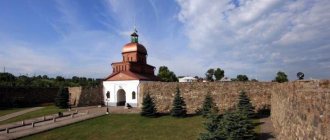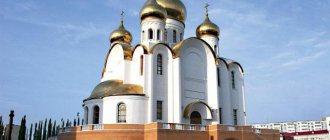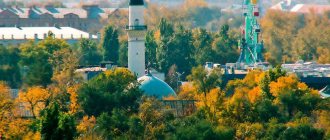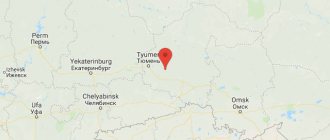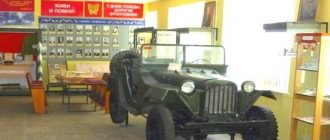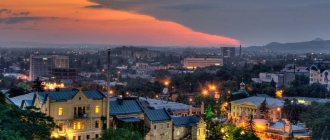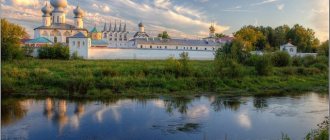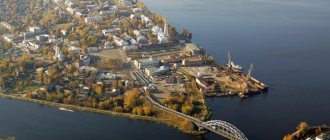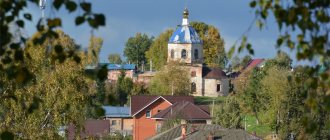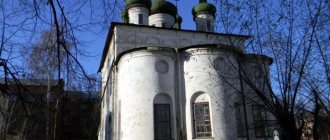Vologda is often called the cultural capital of the Russian North, the Northern Gate, the city of fifty domes and the lace capital of Russia. In general, there are enough epithets to fill an entire article. However, it is always better to see once than to read a hundred times. We are leaving for Vologda.
How to get to this northern city, but not too far from central Russia, was described in the most detail in the article “How to get to Vologda” - with prices, schedules and other data necessary for any tourist, so we will move on to details that are no less practical , but of a different kind. Go.
The main attractions of Vologda
- Kremlin Square and Vologda Kremlin
The Vologda Kremlin, which is the main attraction of the city, began to be built by Ivan the Terrible, and is shaped like an irregular quadrangle. From the northern part it is protected by the river of the same name, in the west and southeast it is surrounded by ditches and earthen ramparts.
Kremlin Square with a bell tower and 3 churches, formerly called Cathedral Square, is located between the Kremlin and Cathedral Hill. The architectural and style differences between the buildings are due to the fact that the development of the area lasted for several centuries.
- Revolution square
Bounded by Sovetsky Avenue and Renaissance Square, Revolution Square is considered the central parade ground of the city.
Until October 1918, there were 3 small squares on this site - Aleksandrovskaya, Spasskaya and Sennaya, which were separated by churches and monasteries. The demolished churches of Athanasius of Alexandria and St. Nicholas the Wonderworker significantly expanded the space. The adjacent cramped city streets highlight the enormous size of Revolution Square.
The history of the buildings located on the square is interesting. The Philharmonic Society occupies the premises of the former Assembly of the Nobility. The children's music school previously housed the City Duma.
In the Komsomolsky park adjacent to the site, an “Eternal Flame” was installed in honor of the fallen Vologda residents. Opposite there is a monument to the heroes of the civil war. The pointed white obelisk is shaped like a tooth, which is how it got its name.
- Monument to the 800th anniversary of the city
Not far from the Vologda Kremlin, on the river bank in the ancient part of the city, called the Lazy Platform, a monument dedicated to the 800th anniversary of the city was erected.
For the monument, which has a quadrangular base, the edges of which are decorated in the form of decorative niches in the form of kokoshniks with inserted bronze bas-reliefs, polished northern granite was used. The authors of the monument are sculptors Kontareva.
- Bishop's Court
The bishop's courtyard is called the small Kremlin. For 5 centuries it was the seat of Vologda bishops. Ivan the Terrible planned to turn the Kremlin into his residence in the north, so for security purposes he built a royal palace inside and surrounded it with high walls with watchtowers.
Now the Bishop's Court includes a number of buildings built in the 16th-18th centuries, which are used for holding exhibitions and storing museum funds.
- Oktyabrsky Bridge
Built in 1931, the Oktyabrsky Bridge replaced the wooden Arkhangelsk Bridge, erected at the end of the 19th century. The reinforced concrete arched span bridge is accessible to pedestrians and cars. The middle arched part of the bridge allows river boats to pass under it.
Resurrection Church
Address: pl. Kremlevskaya, 3B Telephone: Opening hours: from 10:00 to 17:00 (weekends - Monday, Tuesday) Cost: 100 rubles for adults, 500 for students and schoolchildren
The Resurrection Cathedral was built in the 50s of the 18th century, but was almost immediately dismantled due to instability. After 20 years, a building was erected that can still be seen to this day. The Church of the Resurrection was built on the site of one of the towers of the Small Kremlin, using the same stones.
Historians link this building and the construction of the St. Sophia Cathedral into one complex (Resurrection Church - “warm”, winter, St. Sophia - “cold”, summer). And the difference in architectural styles is associated with the dates of construction - they are two centuries apart.
The Church of the Resurrection was built in the Baroque style. This is a two-story building with five domes. The central entrance in the Empire style was added a little later - and this is the only change in the appearance of the original building. Now the Resurrection Cathedral houses the art gallery of the museum-reserve.
Architectural landmarks
The sights of Vologda are distinguished by interesting architectural features.
- House of Peter I
Peter the Great, who visited Vologda 5 times, constantly stayed in a one-story stone building on the high bank of the river. This small building, which became the first Vologda museum, was previously the property of the widow Goutman. Here you can see Dutch ovens with tiles from the 17th century, personal belongings of the emperor.
The museum is located on Sovetsky Prospekt and is open from Wednesday to Sunday from 10 to 17.30. The entrance ticket costs 80 rubles; a discounted ticket is provided for schoolchildren and pensioners.
- Shalamovsky house
Located near the St. Sophia Cathedral, a 2-story building built in the 18th century attracts tourists interested in the literary work of V. Shalamov. The writer’s family lived in this house, which belonged to the Vologda clergy. Now it is a cultural center that unites the Shalamov House and the Art Gallery.
The museum is located on S. Orlova Street, which can be reached from the railway and bus stations by buses 7, 29, 30, 38 (exit at Torgovaya Ploshchad).
The house is open daily, except Monday and Tuesday from 10 to 18 hours. Ticket costs 120 rubles, excursion service 140 rubles. Disadvantaged categories of the population can visit the museum for free.
- House of Puzan-Puzyrevsky
The nobleman Puzan-Puzyrevsky, from where the name of the museum came, actually lived in Vologda in a beautiful 2-story mansion with a superstructure that belonged to him.
The house is interesting because in 1918, evacuated attorneys from embassies, consulates and missions lived there for 5 months, as well as the presence of the ghost of the former owner, who is fighting the careless tenants of the building.
You can get to Herzen Street, which was previously called Ekaterino-Dvoryanskaya, where the interesting house is located, by trolleybus No. 2 or by buses 6, 9, 12, 15, 17, 18, 25, 27, 35, 36, 37, 43, 45, 48, 49 (stop "Galkinskaya").
- House of Zasetskys
Being the oldest surviving wooden building in the city, the Zasetsky House, built in the classicist style, is located on Leningradskaya Street.
The building is included in the list of heritage of wooden architecture of the Vologda region.
The Zasetskys are an old noble family, one of whose representatives became the first local historian and author of a book about Vologda, and also collected a large library and a collection of ancient exhibits of the region. You can get there by bus 7, 8, 11, 27, 29, 32 (exit at the Leningradskaya stop).
- House of merchant Samarin
The only surviving urban wooden estate, built at the beginning of the 20th century, bears the name of the Vologda merchant Samarin.
The museum halls display interesting exhibitions:
- apartment in an old apartment building;
- a pre-revolutionary school, telling about the life of schoolchildren of past centuries;
- a tea salon, where tourists are introduced to the traditions of drinking tea;
- a photo salon where you can get acquainted with photographs of past years, as well as take a photo as a souvenir against the backdrop of the interior of past years in costumes of the past;
- Russian feast, introducing table and culinary traditions.
The museum is located on Sovetsky Prospekt, 16a. You can visit 5 days a week (Wednesday - Sunday) from 10 a.m. to 5 p.m.
- Semenkovo
In the architectural and ethnographic museum "Semenkovo", located 12 km from Vologda, on the banks of the river of the same name, in the monuments of Russian wooden architecture of the 19th-20th centuries. the traditions of life in the Russian village are presented.
In addition to traditional excursions, Semenkovo offers thematic interactive programs that introduce tourists to the traditions and life of the village. The most popular programs are those telling about one day in village life, as well as events from the “Solstice” cycle, timed to coincide with the holidays of the national calendar.
In the museum, upon prior request, folk craftsmen regularly conduct master classes on birch bark weaving, pottery, traditional painting and embroidery, and making folk dolls.
From May to October, the museum is open every day except Mondays from 10 a.m. to 7 p.m., the rest of the time from 10 a.m. to 5 p.m., with Mondays and Tuesdays closed. To receive excursion services, you must make an appointment in advance by calling (8172) 21‑01-90. You can get to the village of Semenkovo along Kirillovskoye Highway.
- Brianchaninovs' estate
Stone manor built in the 19th century. according to the classical traditions of estate construction, it is located near the city, in the village of Pokrovskoye. The beauty of the house is given by the slender proportions, rich plasticity of the facade, and elegant decor.
In the manor park, which runs down the hill in terraces, you can admire examples of landscape art from the 18th-19th centuries. You can get to the estate by bus 217, departing from the bus station three times a day (9, 14, 16) from Wednesday to Sunday.
Due to the small size of the noble house, which accommodates no more than 40 people, tourists need to make an appointment in advance by phone.
House-Museum of Peter I
Address: st. Maria Ulyanova, 33 Telephone: 56-21-07 Opening hours: from 10:00 to 17:00 (closed on Sunday) Cost: 80 rubles for adults, 40 for students and schoolchildren
In addition to the central museum complex, there are several branches in Vologda. Among them is the oldest branch of the museum - the house of Peter I. The building itself was built in the 17th century in the Dutch style (the traditional style for St. Petersburg at that time). The Dutch merchants Gutman also lived here. This family knew Peter well; at one time they helped the emperor, who found himself in the Netherlands without finances. Since then, Peter I visited the Gutmans in Vologda five times. In 1872, the city authorities bought the house and soon opened a museum here.
The exhibition includes about 100 exhibits. The most notable are: the death mask of Peter I, items of his clothing, Prince Menshikov's cup, Dutch chairs from 1704, a soldier's flask, several samples of weapons of that time. Above the entrance to the house there is a coat of arms marking the Dutch mines.
Religious sites
On the territory of Vologda there are holy places, temples and monasteries that attract tourists and pilgrims from all over the world.
- Saint Sophia Cathedral
The Orthodox St. Sophia Cathedral, located on Kremlin Square, was built on the model of the Assumption Church in Moscow. Being the oldest stone structure in the city, it has been well preserved to this day. The cathedral, built according to the classic cross-domed plan, has the shape of a rectangle with 5 attached chapters, topped with onion domes.
The wall paintings and frescoes that make up the interior decoration of the temple were made in the 2nd half of the 17th century. The greatest interest of visitors is the unique fresco with a picture of the Last Judgment.
Currently, the cathedral is part of the Vologda State Museum-Reserve and is available to visitors in the summer. Periodically, services are held here on some church holidays.
- Spaso-Prilutsky Monastery
As part of the Spaso-Prilutsky Dimitriev Orthodox monastery, which is a complex of architectural monuments of the 16th-18th centuries, there is the Spassky Cathedral and the oldest wooden tent-roofed Church of the Assumption.
The monastery was founded by Dmitry Prilutsky, a student of Sergius of Radonezh. The reason for the increased attention to the monastery on the part of Orthodox believers is the relics of its founder resting in one of the cathedrals.
- Kazan Church
The functioning Orthodox Kazan Church, located on Torgovaya Square, is an architectural monument of national significance. The church is cubic in shape, has 1 dome, built at the end of the 18th century. on the site of a wooden one, founded by Ivan the Terrible in the middle of the 16th century.
The temple was painted by painters from the Spaso-Prilutsky Monastery. Now most of the painting has been lost, so the surviving fragments are of great value.
The church is open to believers and tourists; divine services are held regularly, the current schedule of which can be found on social networks (VKontakte group).
- Temple of Helen and Constantine
The Church of the Holy Equal-to-the-Apostles Kings Constantine and Helen, located on Victory Avenue, is an example of a picturesque trend in ancient Russian architecture, widespread in the second half of the 17th century.
In the cold upper floor of the temple, services are held in the summer, and in cold weather, services are held on the first warm floor. The temple is active, the schedule of services can be found on the temple website. You can get to the place by buses 7, 8, 27, 29, 32, 37 (stop “Proletarskaya”).
- Temple of John Chrysostom
Located within walking distance from St. Sophia Cathedral, the Church of St. John Chrysostom is designed in a classical style. At the base there is a five-domed quadrangle, to which galleries adjoin. The unique bell tower, attached to the north-west, attracts the eye with a beautiful octagonal belfry, which is completed by an elegant pyramidal tent.
The shrine kept in the temple - a particle of the relics of St. Alexander of Svirsky - attracts believers and tourists. Currently, work is underway to restore the temple, but services are held every Sunday at 2 p.m. You can get to the temple by crossing the river from the St. Sophia Cathedral along the pedestrian Red Bridge.
Vologda – the city of the Silver Necklace of Russia
More recently, Vologda became one of the cities of the Silver Necklace of Russia. We all know about the Golden Ring, but here, although less precious, it is more massive. Although, having assessed the list of cities included in the necklace, you can’t help but think about it, because Vologda is included in the company of Pskov, Izborsk, Pechory, Staraya Russa, Veliky Novgorod and, attention, St. Petersburg.
Why did it happen that Peter is wearing silver and not gold? In fact, everything is simple - rings and necklaces were invented not on the principle of value (such an approach is, perhaps, not applicable to cities at all), but solely on a geographical principle - in contrast to the Golden Ring of Russia, which mainly covers the cities of Vladimir-Suzdal Rus', in The silver necklace of Russia includes the cities of the Novgorod land, which now surround the city of St. Petersburg.
Museums and theaters
- Lace Museum
Vologda, whose attractions are located on the Kremlin Square, constantly attracts tourists. At the Lace Museum you can get acquainted with the traditional artistic craft of this region, get information about the development of lace making in Europe in the 19th-21st centuries, and admire the original products of specialists from the Snezhinka association.
You can get to the museum by buses 4, 7, 8, 11, 14, 16, 22, 27, 29, 30, exit at the stop "). The museum is open 5 days a week from Wednesday to Sunday from 10 to 17 hours. The entrance ticket costs 100 rubles; for schoolchildren, students, and pensioners there is a discounted ticket for 50 rubles.
- Museum "World of Forgotten Things"
Exhibitions of the museum “The World of Forgotten Things”, located in the restored interiors of a 19th century mansion. immerse visitors in the atmosphere of that time.
The museum is located on Leningradskaya Street, you can get to it by buses 7, 8, 11, 16, 22, 27, 29, 32, 37, 37E, 42 (exit at the Leningradskaya stop). You can visit the museum from Wednesday to Sunday from 10 a.m. to 5 p.m. Information on ticket prices should be checked on the official museum website.
- Museum "Vologda Link"
In the “Vologda Link” museum, located on the street. M. Ulyanova, 33, you can get acquainted with the history of the personalities of political prisoners who served their sentences in these places. The exhibition is housed in a wooden house, in which at the beginning of the 20th century. I.V. Stalin lived as a political settler.
The location of the museum is convenient, within walking distance from the Kremlin Square. The establishment is open from Tuesday to Saturday from 10 to 17 hours. The ticket price is 80 rubles, for schoolchildren, students, and pensioners there is a 50% discount.
- Museum "Literature. Art. Century XX"
There are 4 literary museums in Vologda. One of them, dedicated to literature and art of the 20th century, is located on the street. Herzen, 36. In the museum you can get acquainted with the life and work of the lyrical poet N. Rubtsov, who wrote about the nature of the North, and the composer V. Gavrilin, whose works can be heard in the halls of the museum. The presented books, photographs, and documents reflect the era of that time.
You can view the exhibition by taking buses 6, 37, 40 or trolleybus 5 from the station to the stop “ul. Herzen" or from the Vologda Kremlin by bus 27 to the "Galkinskaya" stop. Ticket prices and opening hours can be found on the museum’s website.
- Vologda Drama Theater
Vologda Drama Theater, which in the middle of the 19th century. founded by entrepreneur B. Solovyov, offers performances by classics and contemporaries on three stages - main, small and chamber. The theater is located on Sovetsky Prospect; detailed information about the repertoire and tickets can be obtained by calling 8172 72‑61-66 or on the theater website.
- Gallery "Red Bridge"
The art gallery of contemporary art "Red Bridge" presents works of artists of past generations working in the style of realism, symbolism, as well as works of modern authors who use original ways of expressing their own thoughts and feelings.
The gallery is located near the bridge of the same name, on the 6th Army Embankment, and is open daily, except Fridays, from 10 a.m. to 6 p.m. The entrance ticket for adults costs 50 rubles, for children, students and pensioners 35 rubles. On Thursday you can visit the museum for free.
Complex “World of Forgotten Things”
Address: st. Leningradskaya, 6 Telephone: 21-14-17 Opening hours: from 10:00 to 17:00 (weekends - Monday, Tuesday) Cost: 80 rubles for adults, 40 - for students and schoolchildren
In a wooden mansion from the mid-19th century, there is an ethnographic exhibition “with a soul.” On the ground floor of the building there are collected things that are no longer used in everyday life. From these, the exhibition creators carefully recreated the interiors of the living room, nursery and dining room of the early 20th century. Visitors can experience the life and culture of the pre-revolutionary era. The second floor of the mansion is reserved for an exhibition of regional portraiture. On the third floor, periodic exhibitions of items from the family funds of city residents are held.
In addition to traditional exhibitions, the museum hosts creative meetings, musical evenings, and holidays for children. Modern residents of Vologda often come here to talk about their noble ancestors and show antiques and family heirlooms.
Sculptures and monuments
- Monument to the letter "O"
On the 865th birthday of the city, the square near Cathedral Hill was decorated with an original monument to the letter “O”, which reflects the peculiarities of the dialect of local residents. A popular urban metal sculpture 2.5 m high immortalizes the favorite letter of Vologda residents, found in most local names.
Turning into the park after leaving the Vologda Kremlin, you can easily find this monument.
- Monument to K. N. Batyushkov
On the Kremlin Square of Vologda there is an original monument to the famous poet K. Batyushkov, created by sculptor V. Klykov.
The 4 figures included in the composition reflect the 2 essences of K. Batyushkov - a warrior (the figure of Athena) and a poet (the figure of the Muse). Tourists and locals are advised to rub the Muse's big toe to attract good luck. Vologda residents love this sculpture and ironically call it a horse monument.
- Monument to the electric lantern
To mark the 100th anniversary of equipping the city with electric energy, a monument to the first electric lamp was erected on Prechistenskaya embankment. An exact copy of a lamppost from the early 20th century. is located near the pedestrian bridge, not far from the city's puppet theater.
Architect E. Nikitina, in order to add charm and color to the sculpture, supplemented the sculpture with the figure of a dog relieving itself on a pillar. Witty city residents call the composition “Monument to the Pissing Dog.”
- Monument to Nikolai Rubtsov
The sculpture of the Russian poet N. Rubtsov by A. M. Shebunin is installed in Petrovsky Square, which stretches along Sovetsky Prospekt. The figure of Rubtsov is made in full height, and the poet’s gaze, addressed to his descendants, is filled with romance.
pros
- In winter it is impossible to travel, as in summer, with tents in cars. For a comfortable stay you need a warm hotel . Vologda has a sufficient number (more than 40) of guest houses and hotels from budget to expensive options. All are located close to the center, because Vologda is a small capital, with about 300 thousand inhabitants. And you can travel the entire city from beginning to end simply by bus.
- Taxis are especially important in winter. Tourists in Vologda don’t have to bother too much with buses; taxi prices in the city are more than reasonable . But private operators at the station often deceive tourists and inflate the price for the trip, so it is better to call a taxi through an operator.
- In winter, the Vologda River turns into one continuous ski track , which will especially appeal to sports enthusiasts. You can also ride around on cheesecakes, which are immediately available for rent. And on New Year's holidays, Father Frost invites children to ride on a sleigh and on a snowmobile. Locals will gladly ride horses, ponies, donkeys and even camels for a small fee.
- In winter, the river attracts not only lovers of winter fun, but also connoisseurs of winter fishing . If you have the desire and your own fishing rod, you can drill a hole there and go fishing for free. You can ask local fishermen for an ice screw.
- In winter, the city is decorated with New Year's illumination . And the ancient houses, mansions, temples along the central streets amaze with their mystery and beauty. In the evening the entire city center is in bright lights. According to tradition, on New Year's holidays there are daytime festivities on the two main squares of the city, mummers light a fire in the Kremlin garden and treat everyone to free mulled wine.
- Vologda museums and galleries will help guests of the city to warm up and have an informative time . Of these, we can highlight the Lace Museum - this is a whole universe woven by the hands of lacemakers. Also in Vologda, most of the existing religious buildings are accessible for visiting in winter. In total there are 63 churches and 12 monasteries in the city.
Interesting and unusual places
- Vologda, whose sights can be found at every step, is famous for its open forged door installed at the intersection of several streets - Burmaginy, Leningradskaya, Mayakovsky. Any wish will come true if, after passing through it, you knock on the knocker that replaces the door handle.
- On Blagoveshchenskaya Street near 24 there is an unusual sculpture - a bench of reconciliation. Consisting of 2 inclined marble slabs, the bench does not allow you to stay on the edge; it necessarily rolls towards the center. Getting closer to each other is so necessary for those who are in a quarrel.
The fitting bench is a landmark in Vologda who is in a quarrel - Installed on Zosimovskaya street. the artifact helps improve your financial condition. By placing your hand on it, you can recharge yourself with the world energy of money.
- You can admire the carved fence, sung by the Belarusian ensemble “Pesnyary”, on Blagoveshchenskaya Street, 34
- On Pushkinskaya Street there are bronze doves that coo on the lovers' bench.
Vologda State Museum-Reserve
The list of the most visited places by tourists in Vologda includes the Vologda Museum-Reserve. Opened separately at the beginning of the 20th century, a small museum of homeland studies, a museum in the house of Peter I and an art gallery were combined into a large historical and architectural museum. Today it is the largest museum, which has 48 architectural monuments, 40 exhibitions and 10 active excursion routes. The museum conducts additional research and methodological activities. The museum staff additionally works with other centers of the city and region in order to improve and create interesting exhibitions.
Where to go with a child in Vologda
- With children it is interesting to visit the Park of Culture and Recreation of Labor Veterans, located on the street. Nekrasov and the Park in front of the House of Culture of the Bearing Plant, located on Leningradskaya Street, where you can go on rides or rent equipment.
| Ferris wheel | 50 rub |
| Colliding cars | |
| Train on the railway | |
| Carousels | |
| Bicycle rental, quad biking, catamaran riding | From 100 rub. |
| Theatrical performance with the participation of fairy-tale characters | 150 rub. |
| Electric car rental for children under 7 years old | 100 rub for 7 minutes |
| Children's town with slides and labyrinths | for free |
In the Palace of Culture there is a dino amusement park “The Lost World”, where you can:
- meet dinosaurs;
- play in the interactive sandbox;
- conquer the climbing wall;
- go through the mesh maze;
- visit the 3-D room;
- take part in educational games.
The cost of a 1-hour visit for a child is 250 rubles, for children under 3 years of age admission is free, for an accompanying adult - 150 rubles. Preferential categories of citizens can take advantage of a discount of 50 rubles.
- The Botanical Garden is open daily from 9 a.m. to 5 p.m., a full ticket costs 250 rubles, a child ticket costs 150 rubles. Located in Ershovsky Lane.
- The Einstein Museum of Entertaining Sciences, located on Leningradskaya Street, operates in the format of learning through play, and a playground is open. The exhibits in the museum can be touched and tested in action. A child ticket costs 350 rubles, an adult 150 rubles, 1 hour on the playground 200 rubles.
Bell tower of St. Sophia Cathedral
The modern bell tower in the Gothic style with a gilded dome is the fifth version of the belfry. The previous wooden ones burned down, and the low stone version was dismantled. The total height including the cross is 78.5 meters. The collection of bells of Russian, Dutch, and German masters escaped being poured into cannons under Peter the Great and destroyed under Soviet rule.
The ringing can be heard every Sunday at 13:00. The bell tower chimes, produced by the Moscow factory of the Butinop brothers, regularly ring the time every day.
In the summer you can go up to the observation deck and see Vologda from a bird's eye view in the literal sense of the word.
There are no high-rise buildings in the central and trans-river parts of the city, so the view is simply fantastic! On a sunny day you can even see the Prilutsky Monastery 7.5 km away.
What to see in Vologda in 1 day
Vologda, whose attractions are concentrated in the center, can initially be viewed from the Lazy Platform or Cathedral Hill, where significant objects of the Vologda Kremlin are clearly visible.
Near the Kremlin Square there are iconic places of the city:
- Lace Museum;
- House of V. Shalamov;
- Resurrection Cathedral;
- Nevsky Temple;
- monuments to Batyushkov, the letter “O”.
Next you can explore the Church of the Intercession, which is an architectural monument. On the opposite side of the river you can see the 6th Army Embankment with the Sretenskaya Church located on it.
From Kremlin Square it is easy to reach historical churches - the Church of Elijah the Prophet and the Church of Varlaam Khutynsky. Here you can also see the exhibitions of the Museum of Forgotten Things, located in a merchant's mansion.
Complex “Vologda at the turn of the century”
Address: Sovetsky Ave., 16A Telephone: 72-43-11 Opening hours: from 10:00 to 17:00 (weekends - Monday, Tuesday) Cost: 80 rubles for adults, 40 for students and schoolchildren
The museum complex, which is also a branch of the museum-reserve, is located in three traditional wooden houses of the late 19th century. In the apartment building there is a museum where visitors can learn about the life of Vologda before the revolution. There are thematic exhibitions here, as well as a memorial apartment for M. I. Ulyanova (sister of V. I. Lenin), who lived here in exile.
The merchants' shop houses a museum complex store, various creative studios (embroidery, weaving, painting), and often organizes exhibitions and popular science lectures. A system of subscriptions and entertainment events is provided for regular visitors.
What to see in Vologda in 2-3 days
The first day can be devoted to exploring the central part of the city.
The next day, continue the tour by visiting the museum, located in the building of the Noble Assembly at the intersection of Pushkin and Lermontov streets and the existing stone Church of John the Baptist, located in the Pushkin Garden. Nearby are the A. Komelsky Chapel and the Vologda Link Museum, which are also significant places in the city. On Sovetsky Prospekt you can visit Petrovsky House. Another possible route is a walk along the Red Bridge and inspection of temples and architectural monuments on the opposite bank.
On the third day, it is better to see distant objects - for example, the northern outskirts of Vologda with the Spaso-Prilutsky Monastery located there. In summer you can get there by pleasure boat. It is good to devote a whole day to visiting the Semenkovo architectural and ethnographic museum.
Vologda churches
Vologda is rich in ancient beautiful churches. There are many of them, and they largely determine the silhouette of the city, making the center of Vologda similar to Suzdal. It is impossible to visit them all in one day. But we visited some of those closer to the center.
The Church of John the Baptist in Roshchenye is the first church we entered, located near the central square. When we approached it, it was still closed, but they kindly let us in. The church is being restored, but as a local woman said, the restoration has taken a long time and requires more and more money. Built in 1710 by Yaroslavl craftsmen, the inside of the church is painted with wonderful frescoes, which, unfortunately, were very badly damaged by floods. In the spring, Vologda is flooded with meltwater, and the lower part of the frescoes has almost disappeared from dampness.
Kazan Church, originally wooden, built in the 16th century, then rebuilt from brick.
Church of the Intercession on Kozlen of the early 18th century.
Church of the Intercession at Torg, 18th century.
Church of Alexander Nevsky of the 18th century.
The Teremok Puppet Theater is located in the building of the former church of Zosima and Savvaty Solovetsky.
On the opposite, left bank of the Vologda River, we admired several more churches.
Church of St. Nicholas the Wonderworker in Vladychnaya Sloboda, a 17th century temple
Church of the Assumption of the Blessed Virgin Mary on Navolok (warm) 18th century
This is not an optical distortion, the architect gave the window this shape
Church of Dmitry Prilutsky (cold), built in 1710. Frescoes from the 18th century have been preserved inside. Unfortunately, it was closed.
What to bring from Vologda
You can bring as souvenirs:
- Delicate hand-woven bobbin lace items, including the recently popular lace-patterned T-shirts.
- Fragrant, with a slight nutty flavor, Vologda oil.
- Silver tableware and jewelry made using the blackening method.
- Products from Vologda birch bark.
- Boxes, panels, jewelry with enamel.
- Pottery products made from local red clay.
- Vologda felt boots.
- Linen tablecloths, towels, napkins, socks.
- Christmas decorations.
- Crafts from their juniper.
- Dishes made from Semikarakor faience.
The sights of Vologda, captured in photographs, and the local souvenirs brought will leave the beauty of this northern region in your memory for a long time.
Author: Marina K.
Article design: Mila Friedan
Results
Approximate routes for 2 days can help you decide on the places that you will be interested in visiting and how best to do it. It is recommended to explore the main attractions of the city on the first day, accompanied by a guide and a tour group. Then you will not only be able to enjoy the unique monuments of architecture and ancient Russian architecture, but also learn the history of these places, which goes deep into the era of the Tsars.
On the second day, you can go to the surrounding area and continue to enjoy the beauty and sights of the Vologda region.
Vologda Regional Puppet Theater "Teremok"
The theater got its name due to the appearance of the building in which it was located in the 70s of the last century. Inside it has a cloakroom, a lower foyer, a winter garden and an auditorium. The chairs in the hall are designed specifically for small spectators so that they can see the stage on a par with adults. After the performance, the children can draw in a special children's corner. You can visit the theater every day, except Monday and Tuesday, according to the schedule of performances.
Governor's House
The Governor's House is one of the main architectural attractions of Vologda. The 18th century building attracts the gaze of all passersby. The beautiful facade with graceful window openings and columns at the entrance looks very solemn. Today, this building houses the administration of the President of the Russian Federation. The hall and reception area are also used for ceremonial registrations of marriages. The rest of the building is accessible for inspection only by government officials and a few visitors; tours of the Governor's House are not available.

